Interview with Kathy Reichs, Inspiration for the TV Series BONES
Mike Vicic - May 4, 2010

TV Tango recently took part in a conference call with Kathy Reichs, the inspiration for BONES. In this interview, she dishes about the BONES episode she wrote, the Booth-Brennan relationship, the differences between Tempe in the book and the series, and her new book "Spider Bones." Kathy's episode of BONES, "The Witch and the Wardrobe," airs Thursday, May 6 at 8PM ET/PT on Fox.
|
|
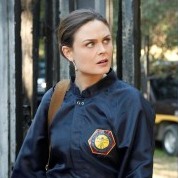 |
Question: Do you see Brennan as two separate people: The character on TV and one that your readers know? Kathy Reichs: No, I really don’t. I think of book Tempe and TV Tempe and I think of TV Tempe as an earlier point in book Tempe’s life. She’s 30-something rather than 40-something. She’s unmarried. She‘s living in Washington, which I find very appropriate because that’s where I started my career at the Smithsonian. It’s the very first place I ever worked with skeletons, so I think of TV Tempe as a prequel. |
|
|
|
Question: Were you told which intern to use and what needed to happen in the B-plot line of "Witch and Wardrobe" or was that your specific idea? Kathy Reichs: That was pretty much formulated by the executive producers. I was told that we were going to be using Clark. |
|
|
|
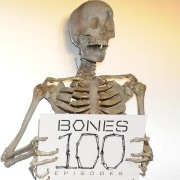 |
Question: How do you see the longevity of the show? Kathy Reichs: Well, I think we should go to a thousand episodes. Everything I hear is that we’re going strongly. It’s been picked up for the sixth season, of course, and that hopefully we can go several more beyond that. |
|
|
|
|
|
Question: How do you see social networking becoming such an important part of promotion and interacting with fans? Kathy Reichs: Well, I’ve just started tweeting inspired largely by Hart Hanson, who is a greater tweeter. And I’m amazed at how I really didn’t understand the power of it, but I’m amazed that if I tweet something, then it gets re-tweeted and re-tweeted, so it really does reach a huge number of people. |
|
|
|
|
Question: Do you have any advice for people who are inspired by you and by the show to pursue forensic anthropology as a career? Kathy Reichs: I’m astounded also at how many emails I get through my Website about kids, or even older people, wanting to go into forensic anthropology or any area of forensics. My advice would be to study the hard science not just take some course in general forensic science. If you want to be an anthropologist, you need to study physical anthropology specialized in bones. If you want to be a forensic chemist, get a degree in chemistry. Do you want to do DNA work? Get a degree in microbiology. And do well. Study hard and go to graduate school. [You can learn more about forensic science at Kathy's website.] |
|
|
|
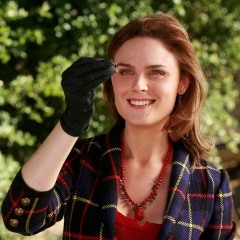 |
Question: Are there any similarities that you see between yourself and either of the two Tempe characters? Kathy Reichs: Well, obviously professionally we do exactly the same thing. I work in the Crime Lab. I go to crime scenes. I work in North Carolina and in Quebec Province in Canada a lot, but I do cases all over the country here and there. Tempe’s tied a little more to the Jeffersonian, but she gets out into the field as well. She’s gone to New Orleans and she’s gone to the Pacific Northwest, I think. So, what we do though is identical. In terms of personality, I think we’re quite different. |
|
Well, one way that we’re similar is sense of humor. I mean, I think we have a similar sense of humor. And that was important in creating the show. That was one thing Hart Hanson and I and Barry Josephson were on the same page about from the get go. But as far as her social awkwardness and her inability to form close relationships, I think we’re different in those ways. |
|
|
|
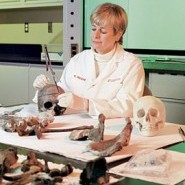 |
Question: What led you to take on a career as a forensic anthropologist? Kathy Reichs: Oh, pure accident actually. I was kind of dragged into it. I trained to do archaeology – and kind of the thing that’s back story for Tempe on the series – but I trained to do archeology and work with ancient skeletons. I was very happily doing that when police started bringing me cases, and once I started doing the coroner work – the medical examiner work – I found that very compelling. I liked the idea of the relevance of it – that you could actually impact someone’s life, which is not necessary true – archaeology is fascinating but if you’re wrong, you’re not going to send anybody to jail or you’re not doing to misidentify a missing person. So, I really liked that and I retrained. I became Board certified, and I’ve been in the forensic anthropology field ever since. |
|
|
|
Question: Has there been a particular case throughout your career that has just totally blown you away with the results that you discovered? Kathy Reichs: I’ve got some that are a little more frustrating than others. I’ve got a few that have yet to be solved. I’ve got, for example, a little child’s skeleton in my lab up in Montreal that I’ve had since 1989 that’s never been ID’d, although I think we may finally get this little guy identified. So, those are always the most frustrating, and I guess those stick in my mind more than others. Probably the most difficult working situation was ground zero, working at the Trade Center. That was both physically and psychologically very demanding. But each case brings something different to the table, literally. It’s just hard to pick out any one single one. |
|
|
|
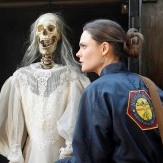 |
Question: Did the story for the "The Witch in the Wardrobe" come from a specific real-life case? Kathy Reichs: Well, not really. It came from a combination of different things. Whenever I write a novel, I always bring different aspects of different cases together and blend them together into one story. So, I’ve had cases where bodies were found covered in some kind of melted goop from a fire, so that kind of figured into it. I’ve had cases where bones were found in coffins or storage lockers or trunks that probably belonged to fraternities or things like that that were dressed in odd clothing or something. So, elements of that came into the story. |
|
|
|
Question: Is there any new technology you’re using in your forensic work that we will see incorporated into the show? Kathy Reichs: Gosh, they do a pretty good job of keeping on top of the science and knowing techniques to bring in from related fields. My primary job as a producer is to work with the writers on the science. But they come up with ideas on their own, then I just kind of thumbs-up, thumbs-down on the accuracy or the feasibility of it. What I do in my lab on a day-to-day basis is really not particularly high tech. I use microscopes and I use saws for cutting bone up and sending samples to the DNA section, but I don’t use a whole lot of razzle-dazzle stuff like Angela, for example. |
|
|
|
 |
Question: Will we see you in anymore guest spots in the future? Kathy Reichs: Every time I’m out there, Hart and I talk about it, and I actually had a whole lot of fun doing it, a lot more. I was initially kind of reluctant to appear on camera and Hart said, "Well I’m going to write a part. If you don’t want to do it, we’ll cast it." And I was still fairly reluctant, and then he told me David Duchovny was directing, so I said, "Oh yes, I am on board." I turned out having a really good time, so yes I would like to do another one. They may have created a monster when they let me go in front of the camera. |
|
That was kind of a real extra bonus to sit around and then it was also the first episode that Ryan O’Neal appeared it. So, to sit around with David Duchovny and Ryan O’Neal and everybody for a couple of weeks, that was a lot of fun. |
|
|
|
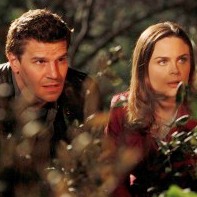 |
Question: In this episode, "Witch and the Wardrobe," what is Booth and Brennan’s relationship is going to be like? Kathy Reichs: They’re getting along pretty well right now I think. I mean they’ve started dating other people, and I leave the character development pretty much to Hart and to the executive producers. I’ve got some interesting plot developments with some of the other characters in my story but not specifically Booth and Brennan. |
|
|
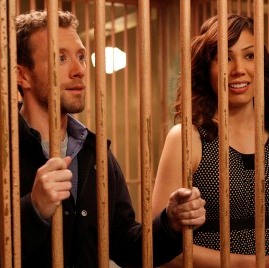 |
Question: What can you tell us about Angela and Hodgins? Kathy Reichs: Angela and Hodgins are getting along pretty well lately, too. I certainly am not going to give away spoilers about who it involves. We’ve got Sweets and Daisy, and we’ve got Angela and Hodgins, and we’ve got Booth and Brennan, and Cam has started dating her OB/GYN guy, so who knows? |
|
|
 |
Question: Is there anything about TV Temperance that you’re kind of jealous of? That you wish you had thought of first for your book Temperance? Kathy Reichs: A lot of the science and the technology that they use on there is really pretty good. I’m sometimes amazed at how they dig out some of the ideas for the different stories, so every now and then I’ll think of "Well, why didn’t I think of that," like the Rock ‘n Roll Hall of Fame arena or the urban spelunking arena. In each show we try to visit some different arena – the world of pathological plastic surgery. So when I see that, I’m sometimes thinking, "Hmm. I need to be more creative in my settings." |
|
|
|
Question: How much, if at all, has the success of the show affected book sales? Kathy Reichs: Gosh, I suppose if I took all of the papers they send me with sales in different foreign languages and somehow figured it out and ran a plot chart against the show. I probably have that data somewhere buried in all of that statistics that they give me. I don’t bother with that. I do know I get a lot of input to my Website – and also now that I’m a Twitterer, I am hearing a lot of comments that I didn’t know about your books until I watched the show and now because of the show, I’m reading your books. So I think there’s been quite a bit of positive input because of the show. |
|
|
|
|
Question: Is it ever problematic if and when the readers come in expecting the book to mirror what they saw on the show? Kathy Reichs: I think in season one I got quite a few e-mails or again, visits to the Website, saying "Wait a minute. This isn’t Tempe. This is different." But now, I tend to get, "Oh, initially I was resistant but I love it. I love both. It’s just like two different manifestations of this character that I like so much." So, I do think there was some reaction, maybe negative reaction, initially, but I don’t think that’s true anymore. People understand that we had a younger Tempe, a 30-something Tempe on TV, and we got a 40-something – we’re pretty vague about her age in the books. But they understand that that’s an older part of the character. |
|
|
|
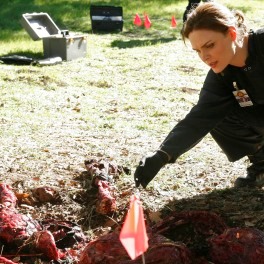 |
Question: Do you ever find it remarkable how in 1990s television crime drama, the scientists gathering evidence would be guys in the background, and now a decade later, not only do we know what these little characters are doing, we know all the different forensic disciplines? Kathy Reichs: Well and people are interested in it. That’s what’s amazing. We did our work in our labs for years and nobody paid any attention to us. As you say, we were indeed background. And then somewhere in the mid-to-late 90’s, there was this swell of interest in forensics. My colleagues and I are totally baffled. We don’t know why all of a sudden we became hot and sexy. |
|
I started writing the early 90’s and sent my book in in 1996, which is not long after the OJ trial. I think maybe that’s where this whole interest came from. People listened to that stuff 24/7 and heard about blood spatter patterns and DNA and angled stab wound trajectory. Otherwise, I’m not sure why it started because we had Quincy back in what the 80’s? When was Quincy? And yet the science wasn’t that big a part of it as I recall. It was really more intuitive, and you’ve had that shift in the novels as well. Murder mysteries now are not so much intuitive and leg-work driven as science driven. |
|
|
|
|
Question: What’s the next Tempe book and when? Kathy Reichs: The Tempe next book will be out in August, August 24th. It’s called "Spider Bones," and it draws on my experience. I consulted for years to our central lab in Honolulu for the identification of our war dead. It’s called JPAC, the Joint POW MIA Accounting Commission. All of our war dead from Southeast Asia, Korea, World War II are identified there. So, it’s going to draw on those experiences, and Tempe will be going to Honolulu to straighten out a mix-up in an ID back in ’68. |
|
|
|
|
Question: Is Canadian law different about forensic work being admissible? Kathy Reichs: I haven’t noticed any differences in the science. One difference in Canada is that you have one set of laws – I explain this to Canadians all the time – you have one set of laws that are national criminal laws whereas in the United States, we have fifty-one different sets. Each state has their own and then, of course, there are some national interstate regulations. So, that’s different. In Canada when I testify, I have to stand up. I don’t get to sit down, and they wear those funny outfits. That’s different. But as far as the application of the science and admissibility of expert witness in court or qualification as an expert witness, I have not noticed any difference. |
|
|
|
|
Question: What brought you to Montreal in the first place? Kathy Reichs: I went there on a national faculty exchange, NFE. It’s a program whereby one faculty member exchanges places with another at another institution for a year. I had just taken some French and this offer came across in the faculty meeting about this opportunity in Montreal, and I thought, "Well, okay, I speak French. I took 101." So, I applied and off I went and during that year of teaching at Miguel and Concordia, the English-language universities in Montreal, I started working at the lab because they wanted someone who was board-certified in forensic anthropology and could speak French. I think they had a pool of one candidate, which was me. So, at the end of that year we just figured out an arrangement, when I came back to North Carolina, where I would commute and I would go to Montreal one week out of every six weeks or so. And I’ve been doing that ever since 1990. |
|
|
|
|
Question: How is the process of writing a television episode for you? Kathy Reichs: Well, it’s really different from writing a novel. For one thing, when I write a novel, I do it alone. I give my idea to my editors and they say that’s splendid, and then I go ahead and I write the book and I send it to them. That’s not how writing a TV episode works. |
|
|
First you have to have your idea approved by the executive producers, your network, the studio, etc., and then when that happens, you write a very lengthy outline, which I don’t usually do for my novels. And then when that’s approved up all the hierarchal levels, then you go and you break the story and it’s a collective experience. You do it with the other writers, which is very different for me. So, that’s what Hart was talking about – breaking a story, I’m told, can take from one to three weeks, and yes, we finished in about 2-1/2 days.
I loved working in the writers’ room. That was to me to have this brain trust, and we’re all bouncing all these ideas off of each other and building on ideas. That was just really a lot of fun for me. And then you pitch it to Hart, in this case, and then he liked it and made a few suggestions and notes, I guess. And then I got sent back and wrote it, and then they change a lot of it, which is also a shock to me. So, it was a very positive experience but a very different experience from writing a novel. |
|
|
|
|
Question: Would you be willing to do it again? Kathy Reichs: Absolutely, yes. I really did have a good time. I learned a lot because it was the first one I had done, so I figure I shouldn’t waste all that newly acquired skill and maybe I should try my hand at a second one if they let me do it. |
|
|
|
|
Question: You’ve been used to writing the Temperance and Andy relationship in your novels. How has it changed to write Booth and Brennan in the TV series? Kathy Reichs: Yes, again, I don’t write. I’ve only written this one episode but to follow their character development. When I agreed to do the series and met with Barry Josephson and Hart Hanson, they convinced me that they would really handle the character development and the story development in a way that was compatible with me, and that they would leave the science ends of it to me. And that’s been our working relationship, and obviously what they’ve done, especially Hart, has been very successful and people have grown to love these characters. So, who am I to question what he does with their future relationship? |
|
|
|
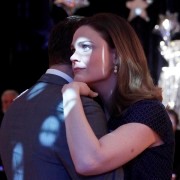 |
Question: You know the fans are split over whether Brennan and Booth should be together as a couple. So, where do you stand in the whole situation? Do you think they should be together or apart? Kathy Reichs: I just think once you do that – once you do the deed – you’re done. If we look at other shows like THE X-FILES or MOONLIGHTING, to me that speaks the beginning of the end. So, I think it’s much better and they play so well at the chemistry. Just from the very beginning from the day that Emily auditioned, the chemistry between them has been so good that I think it’s better to just keep that simmering. |
|
|
|
Question: When you say that you think that the TV Temperance is just a younger version of the book Temperance, then does that mean she won’t end up with Booth? Kathy Reichs: No, not necessarily. We don’t know. My books are taking place like ten or more years later and somewhere in between, she’s gotten married and gotten unmarried to this guy Pete from Chicago. So, who knows what would’ve happened between – she could either end up with Booth and then separate or not end up with Booth, but my books pick up when Tempe is already well into her 40’s. So, it gives a lot of freedom for what’s going to happen with the characters on the show. |
|
|
One other difference is that story. Hart Hanson has given Tempe this backstory with Ryan O’Neal as her father and being abandoned as a child, and her father blowing up, killing the Assistant Director of the FBI, etc. That is just totally different from the backstory in my books, so readers just have to deal with that. That’s just different. |
|
|
|
